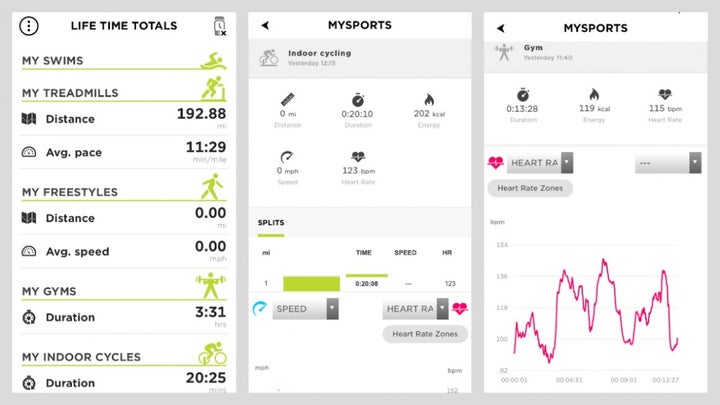
Gamified exercise, bolstered by real-time “fitness data” is proven to increase motivation in the short term, but not the long term.
Thanks to all the new gadgetry, we can track our pulse, GPS coordinates, step count, distance, vertical gain, length of ride, calories burned, metabolic rate, and, well, that was the technology of years ago. Once the sweat dries―or better, in real time―this data can be synched to previous workouts, those of our friends, others online, or the pros. Using the data, “exercise software” can suggest areas of improvement using sophisticated graphs and tables―and you can set notifications/nudges to encourage you to work out harder.
Soon, “smart clothing” will be the new thing, generating a 3D virtual copy of your workout, so you—who began to work out “because it felt good and needed to shed a few”—can now analyze your kinesiological movement like an Olympic trainer. For runners, drones can be programmed at targeted paces, and can therefore act as veritable carrots on a stick while you stride your way to a PB. The in-your-face data produced by fitness trackers don’t lie, either—we become motivated when we soberly view the numbers, and our competitive edge comes out of the closet. It’s a competitive world, after all, and the investment in gamified exercise by so many soft-fit (short for software-fitness) companies is based on studies in neuroscience and motivational research.
But hold on. What, really, is going on here?
Technology has aimed its target at the fitness industry, and now the race is on to improve the “fitness experience.” What’s happening isn’t a conspiracy, but rather a trend in technology. It happened in education with “online universities,” transportation with Uber, music with Pandora, lodging with Airbnb. The list goes on.
Fitness, and what it means to work out and what we are supposed to get out of the workout—spoiler alert: it’s not data―is being redefined by an industry whose track record, let’s face it, is not in favor of cultivating bodily intelligence, which is what fitness is about. As a individual who has been an athlete for the entirety of my life, and one who has worked in technology, I speak as an insider invested in both worlds. But this doesn’t mean I’m ambivalent. There is such a thing as a bad marriage.
What It Means To Be Fit
The application of one thing to another thing isn’t always a good idea, like any relationship pairing. The application of technology to fitness is one of those awkward relationships we need to rethink. And the stakes are high. Furthermore, when you pair two things that shouldn’t be, you inexorably change both.

Fitness trackers produce data, first and foremost. They cannot, by definition, analyze your fitness.
Fitness trackers do not track our fitness. When we think they do, we are inferring something about our physical condition from an analysis of data. Fitness trackers produce data—this is all they do. But what is fitness? Attempting to tack jello to the wall, the United States Department of Health and Human Services offers up its definition of fitness ― “a set of attributes that people have or achieve that relates to the ability to perform physical activity.” Not bad, but this is really saying that being fit helps you exercise. That isn’t true.
Any in-depth study in the history of fitness finds that fit bodies (often how fitness surfaces in history) are produced for differing reasons in history—sometimes they are celebrated for military reasons, other times artistic, as in Greco Roman times or Renaissance Italy. Modern fitness, as a mass market category of physical well being for men and women at large, as a recreational, gym-oriented phenomenon, can be said to begin with the jazzercise movements of the 1970s and ‘80s.
Fitness is indeed what exercise produces, but it does not just help you exercise. The application of fitness is in life, not the gym, and goes far beyond performing “physical activity.” Being fit is a condition that one carries around with them every day.
Having fitness more often than not means having a skill, and, once this skill is cultivated, one approaches the world differently. As an alpinist and climber, when I see a mountain all I see is myself climbing it, searching for a route, predicting dangers or emergency descents. I wonder how far I could go should I get caught in the dark, if that couloir will safely hold snow, or if the rock is solid. Likewise, a cyclist sees a hill and wonders how fast they can climb it. It’s neither superior nor inferior to other modes of perception—it is just one among many.
But here’s the rub ― we only receive the fruit of attuned perception if that perception is cultivated with an equal amount of attention, i.e., mindful workouts. Fitness is an act of attention to the body, first and foremost. It is a time and place where we cultivate a bodily intelligence, which can only be honed from serious attention to the body; like intellectual intelligence, there are no shortcuts. In our information economy, attention is an increasingly scarce resource. Information consumes attention. Fitness, and the process producing it, is one of our best antidotes to cultivating not only attention, but an in-born intelligence of our body. If your workouts are distracted, you will not reap the benefit after the workout. It might sound odd, but it’s true.
The Yoga Watch
As regards attention and technology wanting ours, a recent commercial comes to mind. The commercial is thus—a woman doing yoga, that confident-yet-serene face upon her. Wood floors. Middle aged. She is seated in mindful meditation. But wait, she opens her eyes, if only for a second, to gaze at her fitness watch. Is my pulse right? Am I trending correctly? the scene implies. Back to yoga. It seems harmless, this commercial, but it was one of the most intrusive things I’ve seen regarding the desire of technologies to consume our attention when it shouldn’t be. It is on par with tablet commercials showing families camping by aspen-lined rivers only for the kids to be glued to the screens. Yoga is immensely popular because it frees us from the screens and distraction, and “yokes” us—the original inspiration of the word yoga—to our bodies and minds and how the two are inextricably women together. Yoga is just an example, but strict attention needs to be given to any athletic endeavor or movement, whether you are kayaking or working out in the gym. Body builders know well that when doing reps, the muscle will respond the more you focus on it and the movement. As an interface between us and our bodies, most of the current soft-fit products are trojan horses: we allow them into our lives with the hope of a increased awareness of our bodies, but they cannot, by definition, provide increased bodily awareness because, in fact, they take attention away from our bodies. Data and screens are not substitutes for the body.

“But it’s harmless,” we tell ourselves. “Wearing a smart watch or iPhone doesn’t change anything.”
But the body knows. It pays attention. It knows if you are focusing on it. If it begins to think it is working out so as to produce data, the body will become mad. It will send you hints. It will try its best to reach out to you. The body will lose motivation to workout. It will stop working hard for you. The accumulation of bodily intelligence that can be built up via exercise will cease. The body will no longer crave exercise, either, since you are not feeding it properly. Which is exactly what studies report of those who use fitness trackers vs. those who don’t—the former lose motivation. Motivation is the fuel of fitness—lose that and you’ve lost. It’s not you who lost motivation. It is coming from deep inside your body. Why would it want to exercise if it isn’t getting anything out of it? Your body doesn’t want data from exercise, it wants to refine itself, learn a new skill, find a new freedom. Your body wants to go for a ride, get uncaged, and feel the wind on its skin. It wants you to want that too.